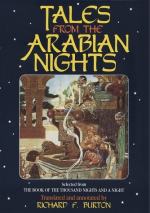[FN#186] In text “Al-Jay’a” which is a well-omened stone like the ’Akik=carnelian. The Arabs still retain our mediaeval superstitions concerning precious stones, and of these fancies I will quote a few. The ruby appeases thirst, strengthens cardiac action and averts plague and “thunderbolts.” The diamond heals diseases, and is a specific against epilepsy or the “possession” by evil spirits: this is also the specialty of the emerald, which, moreover, cures ophthalmia and the stings of scorpions and bites of venomous reptiles, blinding them if placed before their eyes. The turquoise is peculiarly auspicious, abating fascination, strengthening the sight, and, if worn in a ring, increasing the milk of nursing mothers: hence the blue beads hung as necklaces to cattle. The topaz (being yellow) is a prophylactic against jaundice and bilious diseases. The bloodstone when shown to men in rage causes their wrath to depart: it arrests hemorrhage, heals toothache, preserves from bad luck, and is a pledge of long life and happiness. The “cat’s-eye” nullifies Al-Ayn=malign influence by the look, and worn in battle makes the wearer invisible to his foe. This is but a “fist-full out of a donkey-load,” as the Persians say: the subject is a favourite with Eastern writers.
[FN#187] Or white lead: in the text it is “Sapidaj,” corresponding with the “Isfidaj” of vol. vi. 126.
[FN#188] In the text “Bashkhanah”; corr. of the Pers. “Peshkhanah"=state-tents sent forward on the march.
[FN#189] This phrase, twice repeated, is the regular formula of the Rawi or professional reciter; he most unjustifiably, however, neglects the “Inshallah.”
[FN#190] The revetment of the old wells in Arabia is mostly of dry masonry.
[FN#191] [Ar. “Tawanis,” with a long final to rhyme with “Kawadis,” instead of the usual “Tawanis,” pl. of “Taunas,” which Dozy (Suppl. s.v.) identifies with the Greek in the sense of cable.—St.]
[FN#192] In Arab. “Hajarata ’l-Bahraman.”
[FN#193] In text “Zamaku-ha.”
[FN#194] I can see little pertinence in this couplet: but that is not a sine qua non amongst Arabs. Perhaps, however, the Princess understands that she is in a gorgeous prison and relieves her heart by a cunning hint.
[FN#195] I again omit “Saith the Reciter of this marvellous relation,” a formula which occurs with unpleasant reiteration.
[FN#196] i.e. she cried “Astaghfiru ’llah” (which strangers usually pronounce “Astaffira ’llah"); a pious exclamation, humbling oneself before the Creator, and used in a score of different senses, which are not to be found in the dictionaries.
[FN#197] In vol. viii. 183, there are two couplets of which the first is here repeated.
[FN#198] [Here the translator seems to read “Khams Ghaffar,"=five pardoners,where however, grammar requires a plural after “khams.” I take “khams” to be a clerical error for “Khamr"=wine, and read the next word “’ukar,” which is another name for wine, but is also used adjectively together with the former, as in the Breslau Edition iv. 6 “al-Khamr al-’ukar"=choice wine.—St.]




